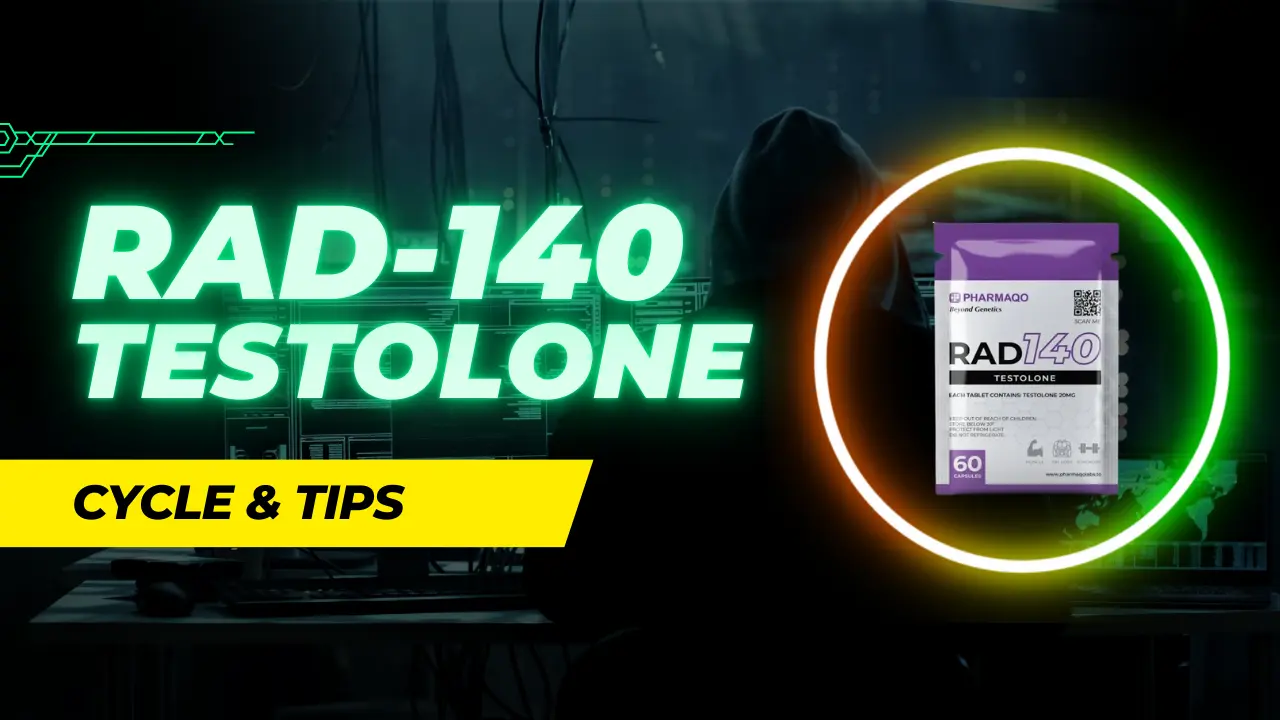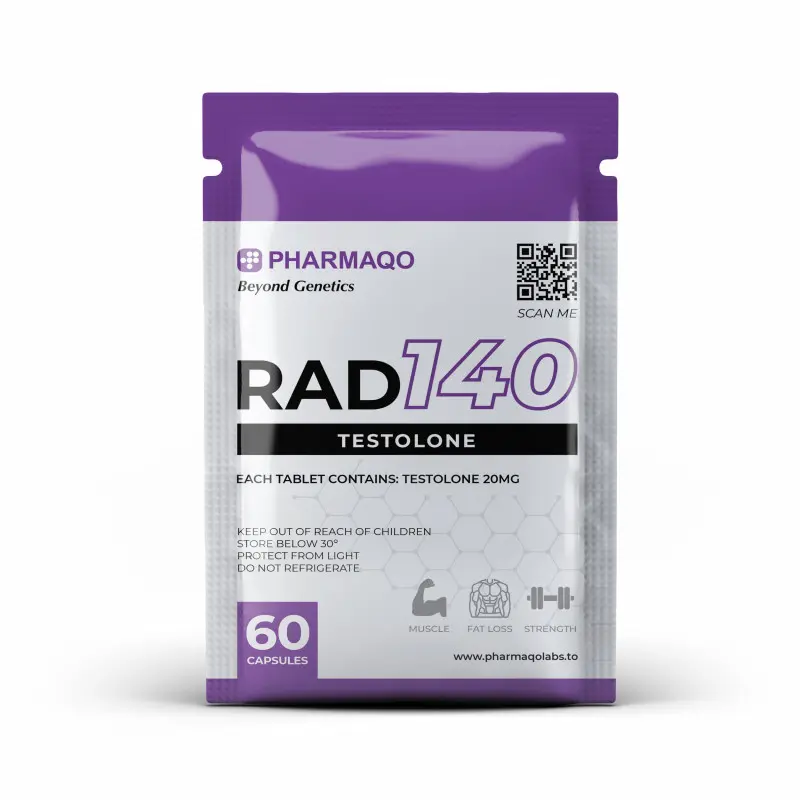The information provided in this article about RAD-140 cycles is strictly for educational and research purposes only. It is not intended to promote, encourage, or endorse the use of any performance-enhancing substances. RAD-140 is not approved for human consumption by regulatory agencies and may pose significant health risks. The long-term effects of RAD-140 use are not fully understood.
RAD-140 (Testolone) stands out as a hot topic among selective androgen receptor modulators (SARMs) in the fitness world. More athletes and bodybuilders now choose RAD-140 cycles instead of traditional performance enhancers. The compound catches attention because it helps build muscle and strength while showing different risks than anabolic steroids.
You need to know the right RAD-140 cycle length, dosage, and safety protocols before starting this SARM. This detailed guide gets into everything about RAD-140 usage – from recommended dosages to cycle timing. You’ll learn about the benefits, safety measures, post-cycle therapy needs, side effects, and the current legal status of RAD-140.
What is RAD-140?
Vosilasarm, also known as RAD-140 or Testolone, marks one of the most important breakthroughs in selective androgen receptor modulator (SARM) technology. Medical researchers developed this compound to treat hormone-sensitive breast cancer, and it has got substantial attention in medical research because of its unique properties.
Definition and classification as a SARM
RAD-140 is a nonsteroidal SARM that selectively binds to androgen receptors. The compound shows a remarkable binding affinity to androgen receptors with a Ki value of 7 nM, which outperforms testosterone’s 29 nM and DHT’s 10 nM. This high specificity works especially well when targeting specific tissues and minimizes effects on others.
Key properties of RAD-140 include:
- Oral bioavailability without requiring injection
- Tissue-selective androgenic activity
- Non-aromatizing compound
- Selective action on muscle and bone tissue
How RAD-140 works in the body
RAD-140 works through a precise mechanism of selective tissue activation. Clinical studies showed the compound worked by a lot with an EC50 value of 0.1 nM in osteoblast differentiation 1. The tissue selectivity shows through:
- Muscle tissue: Acts as a full agonist and promotes muscle growth and strength
- Bone tissue: Improves bone density through selective activation
- Prostate tissue: Functions as a partial agonist/antagonist and limits unwanted effects
Research proves that RAD-140 gets more and thus encourages more muscle growth at doses that are by a lot lower than those needed for prostate stimulation. Studies with cynomolgus monkeys at doses of 0.1 mg/kg/day and higher led to a 10% increase in body weight
Comparison to anabolic steroids
RAD-140 is fundamentally different from traditional anabolic steroids in several ways:
| Characteristic | RAD-140 | Traditional Steroids |
|---|---|---|
| Tissue Selectivity | High selectivity for muscle and bone | Broad systemic effects |
| Conversion Risk | No conversion to estrogen or DHT | Can convert to various metabolites |
| Administration | Oral bioavailability | Often requires injection |
| Organ Impact | Limited prostate effects | Major prostate effects |
The compound’s selective nature comes from its unique molecular structure and binding properties. RAD-140 doesn’t act as a substrate for aromatase or 5α-reductase enzymes. This prevents its conversion into estrogen or more potent androgens and reduces unwanted side effects.
Research has shown more benefits, including its potential to protect nerve cells. Studies show that RAD-140 can boost cell survival against specific toxicity and activate protective MAPK-signaling pathways. Clinical trials have tested doses between 50 and 150 mg/day, and researchers found 100 mg/day to be the maximum safe and tolerated dose.
Testolone RAD-140 Dosage and Cycle
RAD-140 dosing and cycling needs careful thought based on several key factors. A person’s experience level and their body’s response to the compound play crucial roles. Scientific studies showed specific protocols that deliver the best results while keeping adverse effects minimal.
Recommended Dosage
RAD-140 dosage varies by a lot depending on your experience and goals. Research shows that beginners should start with 10mg daily. Studies recommend 15-20mg daily for intermediate users. Advanced users can take up to 30mg daily.

The best time to take RAD-140 follows simple guidelines:
- One dose per day works well because of the compound’s half-life
- Take it in the morning or before your workout (about an hour before exercise)
Recommended Cycle Length
RAD-140 cycles usually run for 8 weeks with a required rest period afterward. Research shows these effective cycle patterns:
| Experience Level | Cycle Duration | Break Period |
|---|---|---|
| Beginners | 6-8 weeks | 8 weeks minimum |
| Intermediate | 8-10 weeks | 8 weeks minimum |
| Advanced | 10-12 weeks | 8-10 weeks |
Research shows that seasoned users might choose a shorter 6-week cycle with higher doses, especially when cutting or preparing for competitions. Most experts advise against running cycles longer than 10 weeks unless you’re an experienced user.
RAD-140 Cycle with PCT (10 Weeks + 4 Weeks PCT)
| Week | RAD-140 (mg/day) | Notes |
|---|---|---|
| 1 | 5 | Start cycle, assess tolerance |
| 2 | 10 | Increase if well tolerated |
| 3-4 | 10 | Maintain dosage |
| 5-6 | 15 | Increase if no side effects |
| 7-8 | 20 | Peak dosage |
| 9-10 | 10 | Taper down |
Post Cycle Therapy (PCT)
Start PCT 3 days after the last RAD-140 dose.
| Week | Nolvadex (mg/day) | Notes |
|---|---|---|
| 1-2 | 20 | Start PCT |
| 3-4 | 10 | Taper down PCT |
Important Notes:
- This cycle is designed for intermediate users. Beginners should start with lower doses.
- Monitor for side effects such as headaches, nausea, or mood changes.
- Maintain a balanced diet high in protein and stay well-hydrated.
- Regular exercise is crucial to maximize the benefits of RAD-140.
- Blood work before, during, and after the cycle is highly recommended.
- PCT is essential to help restore natural testosterone production.
RAD 140 Post Cycle Therapy
RAD-140 suppresses natural testosterone production, making post cycle therapy (PCT) a significant part of the treatment. Clinical data shows that PCT protocols should start right after completing the cycle. The standard PCT protocol has:
- Duration: 4 weeks minimum
- Recommended Compounds:
- Clomid: 50mg daily
- Nolvadex: 40mg daily
- Natural testosterone boosters (e.g., Fenugreek, Ashwagandha)
Blood work plays a vital role to determine PCT requirements. The key factors to monitor are:
- Testosterone levels
- Luteinizing Hormone (LH)
- Follicle Stimulating Hormone (FSH)
- Sex Hormone Binding Globulin (SHBG)
Doses below 6mg daily might not need PCT, but higher doses need proper post-cycle protocols. Each person responds differently, and blood work remains the best way to determine PCT needs.
Users who follow proper cycling and PCT protocols can maintain their gains while reducing potential side effects. Taking recommended breaks allows natural hormone levels to return to normal and lowers the risk of long-term side effects.
The best results come from taking RAD-140 at the same time each day. This helps maintain stable blood levels throughout the cycle. Users can take RAD-140 with or without food, which makes timing more flexible.
Benefits and Effects of RAD-140
Scientific research shows RAD-140 offers multiple benefits that enhance physiological processes. Studies confirm its positive impact on physical performance and brain health.
Muscle growth and strength gains

Research shows RAD-140 affects muscle tissue development through selective androgen receptor activation. Studies indicate that RAD-140 supplements help increase skeletal muscle mass in experimental models. The compound works through:
- Selective targeting of muscle tissue androgen receptors
- Improved protein synthesis mechanisms
- Better nitrogen retention
- Faster muscle fiber development
But research has shown different results across various populations. Some studies with female subjects showed that RAD-140 supplements at 5 mg/kg didn’t work to increase skeletal muscle resiliency or force production.
Fat loss and improved body composition

RAD-140 affects body composition beyond muscle growth. This compound significantly influences metabolic processes that help burn fat. Scientists have observed that RAD-140:
- Speeds up metabolism through increased muscle mass
- Protects lean tissue when you reduce calories
- Helps nutrients reach the right places in your body
Studies show RAD-140’s selective mechanism creates an anabolic environment and supports fat-burning processes simultaneously. This two-way benefit makes it valuable to anyone who wants to reshape their body composition.
Increased endurance and recovery
Research shows how RAD-140 affects athletic performance and recovery metrics. The compound works through several mechanisms that boost endurance:
| Aspect | Observed Effect |
|---|---|
| Recovery Time | Accelerated muscle repair processes |
| Training Volume | Increased work capacity |
| Muscle Endurance | Enhanced stamina during resistance training |
| Protein Synthesis | Elevated rates post-exercise |
RAD-140 helps athletes recover faster between training sessions, which enables more frequent and intense workouts. This quick recovery happens through increased protein synthesis and lower muscle damage markers.
Potential neuroprotective effects
The most important discoveries about RAD-140 relate to how it protects nerve cells. Scientific studies have revealed several key findings:
Research showed that RAD-140 protects nerves similar to testosterone by reducing cell death caused by β-amyloid peptide. The compound offers specific benefits to the nervous system:
- Protection Against Neural Injury: RAD-140 works as well as testosterone to reduce cell death in cultured hippocampal neurons.
- Mechanism of Action: The protective effects work through:
- MAPK signaling pathway activation
- Elevation of ERK phosphorylation
- Inhibition of protection by MEK inhibitor U0126
- Clinical Significance: Research points to possible uses in:
- Protection against age-related cognitive decline
- Reduction of β-amyloid buildup
- Inhibition of tau phosphorylation
Studies confirm that RAD-140 shows strong protective effects on nerve cells in living organisms, specifically in the rat kainate lesion model. The compound excels at:
- Activating neural androgen effects
- Protecting hippocampal neurons from toxic cell death
- Keeping neural health while not affecting prostate tissue
New research reveals that RAD-140 helps cells survive specific types of toxicity based on its concentration. This protection matters especially for:
- Age-related brain conditions
- Defense against cellular stress
- Keeping nerve cells working properly
The compound’s protective abilities stand out because low testosterone levels, which come with age, increase the risk of Alzheimer’s disease. RAD-140 offers an advantage over regular testosterone therapy. It targets specific tissues and protects the brain while leaving the prostate largely unaffected.
These discoveries mark major progress in learning about RAD-140’s potential medical uses beyond muscle growth. The compound knows how to protect nerve cells while targeting specific tissues, making it a promising candidate for future research in preventing and treating brain diseases.
RAD 140 Safety Precautions and Side Effects

RAD-140 shows promising benefits, but knowing its potential risks and safety aspects is significant for safe usage. The latest clinical data highlights several safety concerns that users should think over before they begin a RAD-140 cycle.
What it all means and side effects
Medical observations have documented several most important side effects linked to RAD-140 use. A detailed study showed cases of RAD-140-induced liver injury. Patients showed signs of hyperbilirubinemia in 93.3% of reported cases. These cases ranged in severity, and some patients needed 10 months to 1 year before their laboratory values returned to normal.
Common side effects include:
- Hormonal imbalance that affects mood
- Hair loss or thinning
- Gastrointestinal discomfort
- Increased aggression
- Natural testosterone suppression
Research raises serious concerns about heart health, as studies have connected RAD-140 use to cases of acute myocarditis. Total bilirubin and alkaline phosphatase levels usually reached their peak between days 25-50 of use. The median peak times were 18 and 12 days after patients sought medical care.
Drug interactions and contraindications
RAD-140 poses most important drug interaction risks that need careful thought. Studies show that this compound affects liver function and may change how other medications work in the body. Healthcare provider consultation is essential, and the lack of documented interactions does not guarantee safety.
The most important contraindications include:
| Condition | Risk Level |
|---|---|
| Liver Disease | High Risk |
| Cardiovascular Issues | High Risk |
| Hormone-Sensitive Conditions | Moderate Risk |
| Pre-existing Medical Conditions | Requires Assessment |
Importance of proper sourcing
RAD-140’s quality and purity affect its safety profile. Research shows several hazard statements linked to improper handling:
- Harmful if swallowed
- Causes skin irritation
- May cause respiratory irritation
- Requires careful storage and handling
Doctors should monitor patients for at least 48 hours after adverse reactions because symptoms can develop slowly. Proper sourcing should prioritize products intended for research use only to maintain strict quality control standards.
Make sure to purchase RAD-140 – Laboratory tested that meets high quality standards from trusted source.
Legal status and WADA ban
The World Anti-Doping Agency (WADA) has banned RAD-140 from professional sports. This compound belongs to the S1.2 category of “Other Anabolic Agents” among other SARMs. Between 2015 and 2019, athletes tested positive for SARMs at higher rates.
The regulatory situation raises several key points:
- No medical approval exists
- Laws remain unclear in many areas
- Local regulations need careful review
- Athletes must follow strict testing protocols
Scientists strongly advise against recreational SARM use because it can cause drug-induced liver injury, rhabdomyolysis, and tendon rupture. SARMs have gained popularity through social media channels, which creates a significant public health issue that needs proper oversight and control.
References
[1] – https://en.wikipedia.org/wiki/Vosilasarm
[2] – https://www.sciencedirect.com/science/article/abs/pii/S1526820921002408
[3] – https://www.ncbi.nlm.nih.gov/pmc/articles/PMC3959610/
[4] – https://www.outlookindia.com/hub4health/rad-140-testolone-dosageside-effects-benefits-cycle-stack-sarms-for-cutting-before-and-after-results
[5] – https://www.chemicalbook.com/article/rad140-overview-chemical-characteristics-and-administration.htm
[6] – https://sarmguide.com/rad140-pct/
[7] – https://brutalforce.com/blog/rad140-pct-guide-do-you-need-a-pct-after-testolone/
[8] – https://www.times-standard.com/2023/12/18/rad-140-review-benefits-results-side-effects-cycle-more/
[9] – https://onlinelibrary.wiley.com/doi/10.1111/1440-1681.13824
[10] – https://alz-journals.onlinelibrary.wiley.com/doi/10.1016/j.jalz.2013.05.1102
[11] – https://www.ncbi.nlm.nih.gov/pmc/articles/PMC10204391/
[12] – https://go.drugbank.com/drugs/DB13939
[13] – https://cdn.caymanchem.com/cdn/msds/18773m.pdf
[14] – https://www.wada-ama.org/sites/default/files/prohibited_list_2018_en.pdf
Dr. Grant Fourie, a specialist in male hormones, is based in Cape Town, South Africa. He provides comprehensive treatments for conditions related to low testosterone, such as erectile dysfunction, fatigue, and mood changes. His methods include hormone replacement therapy and other modern treatment options.
Contact me via email or phone to book personal appointment in my clinic: The Village Square, Cape Town - South Africa




